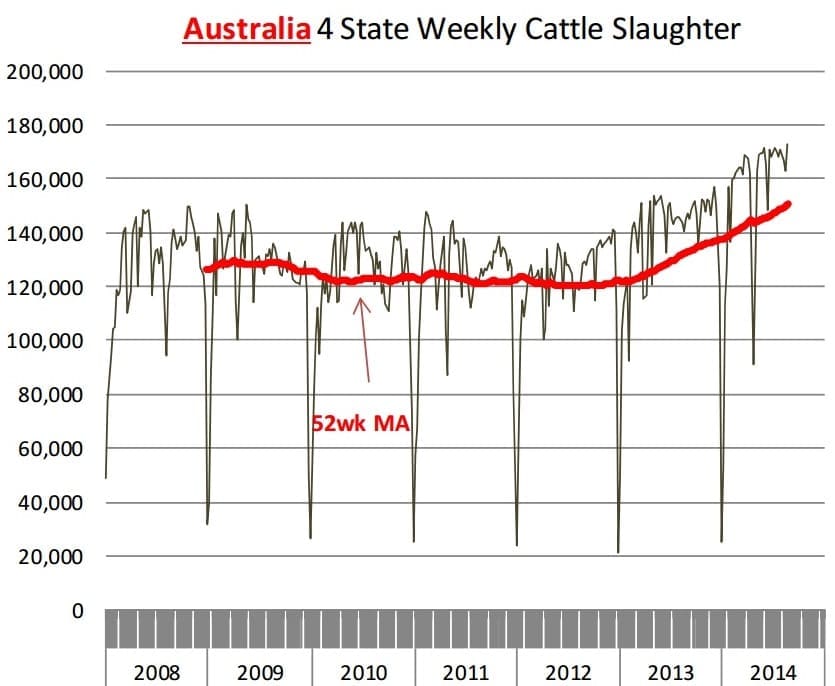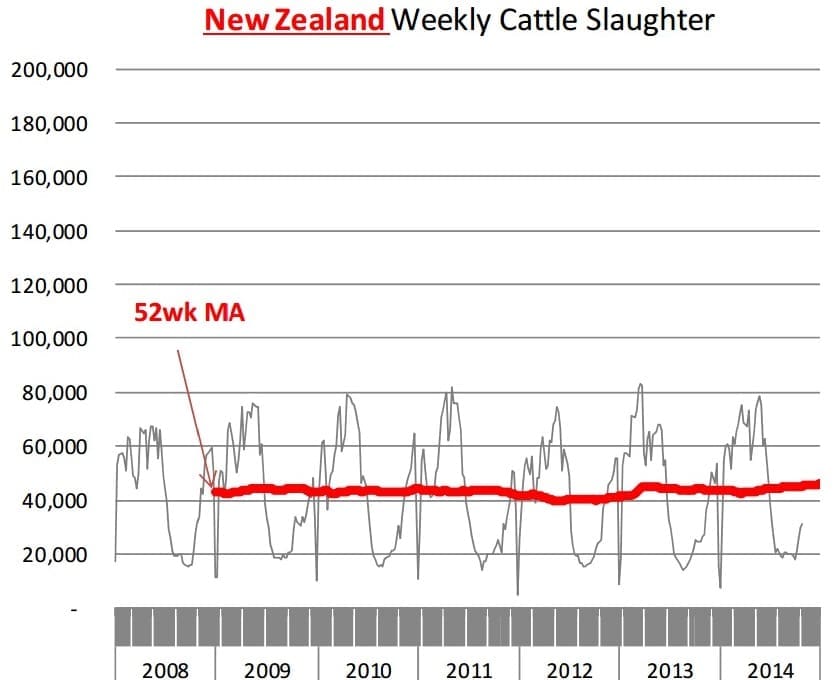IN A normal year, Eastern Australia’s weekly kill numbers often start to dry-up from about mid-November, as killable cattle get scarce. But 2014 has proven to be anything but a normal year.
As the graph published here shows, the trend in Eastern States kill numbers deep into the 2014 slaughter season continues to push ever-higher, as the complete absence of any real spring break in many areas takes dramatic effect.
Worse still, there is little sign of encouragement in what lies ahead, with the Bureau of Meteorology’s latest three month outlook offering no comfort, and large parts of eastern Australia sustaining near record temperatures. On Sunday, Brisbane recorded its hottest day, for any month, since 2008.
It means many Eastern Australian beef producers have absolutely no confidence in what lies ahead, weather wise, and partly explains why the record kills have been sustained so long through the year.
Even as weekly kills around mid-year reached what was regarded as a ‘theoretical capacity’ within available processing resources, kills have kept climbing. There have been no less than 15 weeks over the past six months that have recorded Eastern states weekly kills above 170,000 head.
Last week was no exception, with yet another all-time record set, registering a five states kill of 176,136 head. It’s another 171 head above the previous record set just a few weeks earlier.
The big driver, again, is near-record kills in NSW and Victoria, as dry conditions spread further south.
Victoria’s kill again ventured above 34,000 head, for only the third time in history. The seven-day tally of 34,022 head was up 16pc on the previous week, and 21pc above this time a year ago.
NSW wasn’t far behind, recording 41,244 head for the week, still up 7pc on this time last year.
Queensland’s kill last week was 2pc off the previous week’s pace at 85,752 head, but still 12pc above this time last year. The only reason why Queensland was back at all, was the unusual event of a Friday public holiday in the greater-Brisbane area due to G20, which took the edge off last week’s tally.
While female proportions of the kill in Queensland have declined over the past three months, indicating that female turnoff for drought reasons is now largely exhausted, NSW continued to operate at 55pc females in the mix last week.
That’s next year’s breeding capacity being exported in a carton of grinding meat.
Tasmania also recorded one of its larger recent kills, knocking 5192 head for the week, up 30pc on the previous week, and 16pc on a year ago, while South Australia was responsible for 9886 head, down 1pc on the previous week but still +16pc on 2013.
The graph above also clearly portrays the big slump in weekly slaughter numbers experienced each December/January, as the nation’s largest processors in Queensland and northern NSW enter their seasonal closure period.
As discussed in detail in last week’s kill report (click here to re-visit), many large northern exports sheds will close for business on December 19, taking two to three weeks off before opening the 2015 season either week commencing January 6 or 13.
If it doesn’t rain beforehand, that could leave a lot of droughted cattle without a home.
To compensate for the annual kill closure, most large exporters begin stockpiling beef in cold storage during December, and reports are already coming forward of commercial cold stores around Brisbane starting to lift inventory.
As an aside, a second graph in the sequence published this week by Steiner Consulting is also worth a glance.
It shows the same data-set for New Zealand’s slaughter industry over the past few years.
What’s worth noting, is not only the relatively minor shift in slaughter activity when NZ sustained its own drought last year (red line), but also the incredible seasonality in slaughter experienced in NZ, in comparison with Australia (grey line).
Most Australian processors would look on in horror at the lengthy period each year when NZ slaughter capacity is seriously underutilised, and perhaps goes a long way to explain why mergers are again on the discussion table across the Tasman.
Grids show easing trend, but offers become unreliable
With only four full weeks of slaughter operations left in the 2014 year, direct consignment grids are becoming less reliable, as some large processors are already well-covered for the remainder of the year.
Several Queensland plants spoken to this morning have ceased quoting for the timebeing, while others are only quoting on the week starting December 8, and even then they have heavy commitments to rosters. The concentration of grainfed cattle hitting the market in coming weeks is only adding to the problem.
In essence, there is still just way too many cattle about for the system to cope with.
One large multi-site processor brought its Queensland grids back another 10c/kg over the past week, representing a decline of 25c/kg now on the recent highs.
He quoted four-tooth grassfed heavy steer at 370c/kg down from 395c/kg at the peak, and best heavy cow now at 345c/kg, also back 25c/kg. As it has done all year, MSA grassfed steer pricing remains remarkably robust, quoted yesterday for a SEQ kill at 395c/kg.
Some plans further north might be 5-10c/kg better than those rates, due to the live export influence and the general lack of heavy cattle.
470c/kg cow grids – provided it rains?
If it’s any consolation, Beef Central had an interesting ‘what if?’ discussion with a Queensland processor earlier this week.
Speculation continues to mount about what happens to direct consignment grid prices, come January. This contact told Beef Central that southeast Queensland grids in January were likely to be unchanged from current rates, if there is no widespread break in the weather.
But the upside would be what happens if there is widespread rain during the holiday break. It was purely speculation, but he said he could foresee a top heavy cow price of around 470c/kg dressed weight early next year, a full $1/kg above recent best rates.
At least it is a prospect to cling on to.
For the record: Rumours published in The Australian yesterday suggesting JBS Australia may be about to purchase some or all of the Primo business are apparently without foundation. JBS has told Beef Central twice in the past week that there is nothing in the suggestion that it might purchase Paul Lederer’s 30pc stake, and/or the 70pc stake in Primo held by fund manager, Affinity.





HAVE YOUR SAY